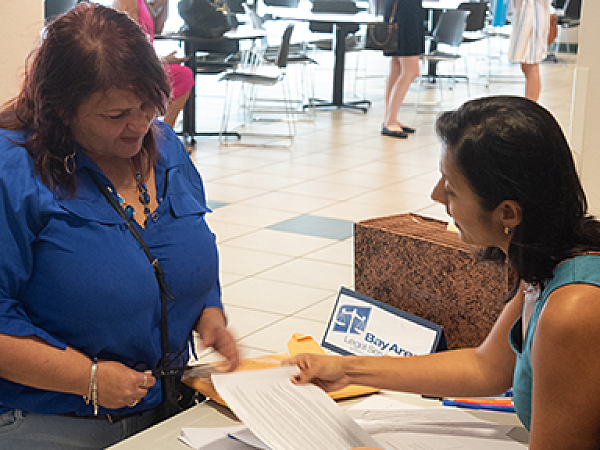🏛️ Resources that may help you during the government shutdown. Learn more →
Understanding FEMA Applications (VIDEO)
Hello, my name is John Lawless, staff attorney with Bay Area Legal Services’ Disaster Relief Team and the Florida Disaster Legal Aid Helpline. I’m here with my colleague Jason to discuss some simple steps anyone can take to avoid common issues while recovering from disaster.
Today, we’re here to discuss FEMA disaster assistance. FEMA provides many different types of assistance, but today we are going to focus on FEMA’s “IHP”, or “Individuals and Households Program.” It is through this program that FEMA provides relief to disaster survivors in the form of money for repairs to their homes and replacement of lost essentials. For the IHP to become available in your area, a few things have to happen.
- First, you need an actual disaster impact. FEMA monitors potential disasters for likely impacts, but cannot provide relief until a disaster actually strikes and impact can be assessed.
- A disaster must also be declared at a Federal level. The physical impact and effects are not enough alone to trigger FEMA relief. The government must also officially declare a disaster exists in an impacted area.
- Also, Individual Assistance, or an “IA” Declaration must be given. This allows FEMA to specifically assist individuals in a declared area. Public assistance often comes first, but this does not provide direct relief to impacted survivors.
Not all disasters reach the level of an individual assistance declaration, and for those disasters FEMA assistance may not be available. One of the easiest ways to find out what sorts of declarations have been made and what assistance program may be available is to contact the local emergency management office for your city or county. Finding these numbers after a disaster can be difficult without power or internet access, so having them in advance and including them in your family’s disaster plan is a good idea. If you can’t a number after a disaster, another good starting point for finding out what kinds of relief are available is to dial “211” on your phone. After a disaster this line can be busy, so it’s also a good idea to prepare yourself for a wait.
If you have power and internet access, you can also check directly with FEMA at their website.
Now that we have an idea of where to start, let’s go to our field correspondent Jason for a look at what applying for relief might look like.
The first thing we’ll need to see in order for FEMA relief to become available is a disaster.
There we go.
The first priority in a disaster is always to get yourself and your family to safety.
It looks like Jason has found a disaster recovery center, or “DRC”. FEMA partners with local government to open these offices in affected areas to help survivors with a variety of needs. FEAM representatives are present to help with the application process. FEMA provides a DRC locator online at this easy to remember address.
You can also just enter “FEMA DRC locator” in any search engine.
FEMA staff can assist if you are on-site at a DRC.
You can also apply for FEMA assistance through disasterassistance.gov without visiting a DRC.
If you are applying on your own though, remember to answer every question. Do not leave blanks.
Great job Jason. Now, let’s take a look.
Keep in mind that the form of the application can change depending on how you apply, the type of disaster, and modifications made due to FEMA updates among other reasons, so in order to avoid confusion I’ll just be taking a look from here.
Uh-oh. Looks like Jason forgot to fill a few things out.
Leaving a blank could cause FEMA to deny your claim, or at least ask for more information. If this happens to you, don’t give up. FEMA allows you to appeal denials, and often they are just asking for more information.
Some of the more common issues to be aware of are:
Remembering to state the specific disaster you are applying for relief from is important. This may sound easy now, but the fatigue faced by survivors can be extreme and this can lead to simple mistakes such as forgetting this information, or even just to provide it, if you are not careful.
Being willing to relocate often confuses applicants too, because it is not clear what FEMA means to ask here. Being willing to relocate really only means relocating long enough for repairs to be completed. Many applications are denied because applicants think this means a permanent move, but all FEMA wants to know is whether you’re willing to give contractors space to work before you return.
Finally, applicants are often confused about whether their home is considered safe and livable. FEMA wants to ensure that survivors are in safe and sanitary conditions. Many survivors instead take this to mean whether they can technically still live in their homes, such as by tarping a hole and avoiding a room with roof damage. FEMA considers this a hazard however, and a homeowner in that situation is still potentially eligible for relief.
Now, if you and your family keep these tips in mind, you’ll be a lot more resilient in the aftermath of disaster, and a lot less like Jason.
We appreciate you taking the time to listen. For more information on what to do in the wake of a disaster, please visit the following resources.
Upcoming Legal Clinics
Apply for Services
Apply by phone Monday-Friday, 9 a.m.-4:30 p.m., or apply online anytime for non-emergency legal matters. Language interpreters are available to you at no cost.
Bay Area Legal Services
If you live or have a case in Hillsborough, Pasco, Pinellas, Manatee, or Sarasota counties, we may be able to help.
Statewide Legal Helplines
If you live or have a case in Florida, we may be able to help.
